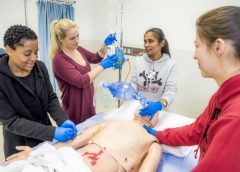Search Results for: p
A partner in wound care
One of the most important steps in achieving positive wound-healing outcomes is to choose the right wound care product. This can be tricky, challenging, and sometimes overwhelming—especially if you’re new to wound care. When I first started in wound care, I had four to five “go-to” products that I knew about. Beyond that, I had to guess what would work. But I learned one thing early: I could call on my sales representatives for help. (more…)
Read MoreWhat does it mean to participate in a wound care clinical trial?
By Susan Beard, RN, BS, CWOCN
Suppose you’re reading an article on a new product that states the product has been through a series of clinical trials before marketing. What does this mean? Who was involved? As a clinician, could you initiate or be involved in a clinical trial of a new product? Who are clinical trial subjects, and what’s it like for them to be involved in a clinical study?
A clinical trial starts as an idea. As clinicians, we often use our critical-thinking skills to imagine a product or method of practice we think could be created or improved on to better meet our patients’ needs. The idea begins to grow and a series of events begins. (more…)
Read MoreHealthcare reform and changes provide opportunities for wound care clinicians
By Kathleen D. Schaum, MS
Qualified healthcare professionals (QHPs), such as physicians, podiatrists, physician assistants, nurse practitioners, and clinical nurse specialists, are taught to diagnose the reasons that chronic wounds aren’t healing and to create plans of care for aggressively managing the wound until it heals. Wound care professionals—nurses and therapists—are taught to implement those plans of care. All of these highly skilled wound care professionals know how to manage chronic wounds from identification through healing. (more…)
Read MoreHelping Sandwich Generation nurses find a work-life balance
By Kari Olson Finnegan, BSN, and Liz Ferron, MSW, LICSW
If you have at least one parent age 65 or older and are raising children or financially supporting a child age 18 or older, you’re part of the Sandwich Generation. Coined in 1981 by social worker Dorothy Miller, the term originally referred to women, generally in their 30s and 40s, who were “sandwiched” between young kids, spouses, employers, and aging parents. While the underlying concept remains the same, over time the definition has expanded to include men and to encompass a larger age range, reflecting the trends of delayed childbearing, grown children moving back home, and elderly parents living longer. The societal phenomenon of the Sandwich Generation increasingly is linked to higher levels of stress and financial uncertainty, as well as such downstream effects as depression and greater health impacts in caregivers. (more…)
Read MoreThe Buzz Report: A wound care clinician’s best friend
By Donna Sardina, RN, MHA, WCC, CWCMS, DWC, OMS
In 2014, more than 8,000 new articles related to wound healing were added to the PubMed online database and hundreds of new patents for topical wound formulations were filed. Staying up-to-date with the latest and greatest findings and products can be challenging. We all lead busy lives, and our demanding work schedules and home responsibilities can thwart our best intentions. Although we know it’s our responsibility to stay abreast of changes in our field, we may feel overwhelmed trying to make that happen. (more…)
Read MorePalliative wound care: Part 1
By Gail Rogers Hebert, MS, RN, CWCN, WCC, DWC, OMS, LNHA
The World Health Organization defines palliative care as “an approach that improves the quality of life of patients and their families facing the problem associated with life-threatening illness, through the prevention and relief of suffering by means of early identification and impeccable assessment and treatment of pain and other problems, physical, psychosocial and spiritual.” (more…)
Read MoreMcKesson Medical-Surgical Launches Skin and Wound Care Portfolio
California hospital’s patient safety protocols now require a wearable
Clinician Resources: United Ostomy Association, NGC, NCCN, Experts
Here is a list of valuable ostomy resources, some suggested by our colleagues who follow Wound Care Advisor on Twitter.
United Ostomy Association of America
The United Ostomy Association of America provides comprehensive resources for patients, including information about the types of ostomies and issues related to nutrition, sexuality, and travel. Much of the information is also available in Spanish and can be downloaded for free from the website. (more…)
Read MoreMake your patient-teaching idea a patented reality
By Joy Hooper, BSN, RN, CWOCN, OMS
Have you ever had an idea for improving patient care that you wanted to market? You may have lacked confidence or know-how, as I once did. But one patient, a crafty idea, and a trip to Walmart put me on the path to becoming a successful nurse entrepreneur. (more…)
Read MoreWhat to do when someone pushes your buttons
By Laura L. Barry, MBA, MMsc, and Maureen Sirois, MSN, RN, CEN, ANP
Why is it that some things don’t bother us, while other things catapult us from an emotional 0 to 60 mph in a heartbeat? We all know what it feels like when someone says or does something that gets our juices flowing. We feel it in our bodies, emotions, and mood. We have an overwhelming urge to react. We may express it in words at the time or take our frustrations out later on someone else. It just doesn’t feel good. We want to explode, set the record straight. (more…)
Read More

